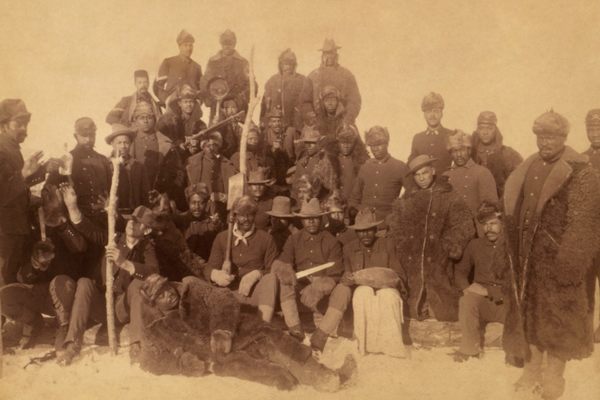The Story Behind the Incredible Obstacle Course Video That Went Viral
It turns out that military competitions are especially nuts.

Competitors in the military pentathlon. (Photo: Alexander Russy/CC BY 2.0)
The blurry video popped up, like so many, on my Facebook feed with no clear source or attribution, just a persistent text at the top reading “HOLY CRAP… THIS IS SO AWESOME” and at the bottom reading “THIS NEEDS TO BE IN THE OLYMPICS.”
jfc this obstacle course is insane https://t.co/PVLfycenfi
— Miguel Gomez (@MexicanMigul) March 14, 2016
The clip, just under two minutes in length, depicts two teams of men completing a relay-type obstacle course that seems impossibly difficult at a pace that makes them look like video game characters. They scale a 30-foot ladder and leap down from the top. They elbow-crawl under a low rope ceiling without slowing down hardly at all from their sprinting pace.
All of a sudden they drop into a rectangular pit placed in the middle of the track like a Wile E. Coyote ploy, and climb out.
It does not appear to be an American event; the shouting from the sidelines is not in English, but the only clue as to where it takes place comes from what may or may not be a Brazilian flag painted on one of the obstacles. The competition is not haphazard, though. These are clearly athletes at the highest echelon of whatever sport this is, and though the video’s production quality is nonexistent, the obstacle course itself is immaculately constructed.
Patient Googling reveals the sport’s true nature: this is one event of a pentathlon. But wait, I thought. The pentathlon? That boring Olympic event nobody watches that involves, like, horse jumping and extremely slow rifle shooting?
It turns out that the world of pentathlons is much larger than the Olympics would suggest. Following this video down the internet rabbit hole led me into a world of elite athletes doing amazing things that nobody has ever heard of—but, as the clip’s text says, it’s awesome.

The first Modern Pentathlon taking place at the 1912 Olympics. (Photo: Public Domain)
The pentathlon in the Olympics is technically called the modern pentathlon. Like many other sports that most people only see in the Olympics, it has military origins. The modern pentathlon made its Olympic debut—really, its world debut, as the event began at the Olympics—in 1912. It was meant to mimic the skills needed by a cavalry soldier, a style of warfare that was, unbeknownst to the pentathlon’s creators, just about dead. (Horses were used in the early parts of World War I, but by the time trench warfare became popular, horses were phased out, and were never a major factor again.)
The modern pentathlon has not changed very much since its inception. It includes fencing, swimming, (slow and precise) shooting, running, and show horse jumping. Aside from the fact that it’s a military-inspired sport with the word “modern” in it that includes thoroughly non-modern elements like show horse jumping and fencing, the modern pentathlon is very boring. (The one wrinkle is that the competitors are given a strange horse to wrangle into competing, and are not allowed to bring their own horse with whom they have any rapport.)
Scintillating it is not. In Beijing, the competition took 12 hours to complete, drew low ratings, and caused the International Olympic Committee consider eliminating it. (It wasn’t; the shooting and running sections were sort of combined, to theoretically make the sport move faster.)
But far more exciting is the event shown in the mysterious viral video: the Military Pentathlon, which began around 1950. It includes five events, namely obstacle racing, obstacle swimming (50-meter race), simulated grenade throwing (competitors have to heave heavy balls into specific spots), running, and both precision and rapid-fire shooting (accurately shoot 10 shots in one minute, rather than one shot every 40 seconds as in the modern pentathlon).

U.S. Army Golden Knights Parachute Team competes at the Military World Games. (Photo: US Army/Public Domain)
The Military Pentathlon is just one of several alterna-pentathlons that are found in competitions like the Military World Games. Others include the Aeronautical Pentathlon, designed for the Air Force, which includes basketball (nobody seems to have a good answer as to why other than “it’s good for eye-hand coordination”). The Naval Pentathlon includes a “seamanship race,” which forces competitors to very quickly tie knots and then row a rowboat.
These significantly better pentathlons are run in tournaments by the Conseil International du Sport Militaire, or CISM. In these tournaments, like the Military World Games, 134 countries send their militaries to compete nonviolently. The Military World Games are an alternate-universe version of the Olympics, held every four years on the year before the summer Olympics (so, the most recent one was in 2015, and was held in South Korea; the next one will be in 2019, in China.) They include some sports that seem not very military-like at all, like handball, basketball, cycling, and volleyball, but also feature some of the more overtly military events that also appear in the Olympics, like archery, a few different types of martial arts, and fencing. The more interesting events are those that don’t appear in the Olympics at all, like the alternate pentathlons, but also including orienteering (basically map-following as sport) and parachuting. Parachuting is especially excellent; it’s most similar to synchronized swimming, but done while free-falling from an airplane.

Leaping through the obstacle course. (Photo: Simone.Pe/CC BY-SA 3.0)
Often there are countries competing that are actively at war with one another, cheering on their own soldiers as they simulate what’s happening on the front lines thousands of miles away right that minute. North Korea competes in the Military World Games, for instance. (They’re good, too, sitting at 9th on the all-time medal list. The U.S. ranks 12th. Russia and China are by far the best at this stuff, or at least the most willing to devote resources to it.)

The swimming component in 2013 in Brazil (Photo: Felipe Barra/ Ministério da Defesa/CC BY 2.0)
That’s no easy feat. The competitors, for one thing, are limited for a simple reason. “In order to take part in the championships organised under the CISM umbrella you have to be in active military duty,” says Alessandro Trono of CISM, who heads up the Military Pentathlon event. It’s unlikely that there are any non-military athletes who would be capable of competing in the Military Pentathlon at any high level.

The Military Pentathlon in progress. (Photo: Alexander Russy/CC BY 2.0)
That said, Trono knows that the Military Pentathlon has potential. He told me that just last week he petitioned the CISM to create an exhibition of the now-viral obstacle relay race in Rio, during the Olympics, “in order to impress the IOC representative about the potentiality of the military unique sport.” The internet would agree.















Follow us on Twitter to get the latest on the world's hidden wonders.
Like us on Facebook to get the latest on the world's hidden wonders.
Follow us on Twitter Like us on Facebook